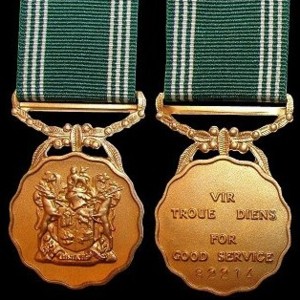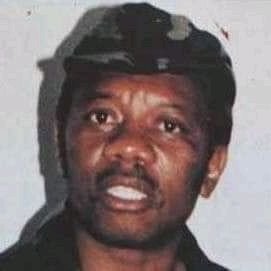
Transkei, officially the Republic of Transkei, was an unrecognised state in the southeastern region of South Africa from 1976 to 1994. It was, along with Ciskei, a Bantustan for the Xhosa people, and operated as a nominally independent parliamentary democracy. Its capital was Umtata.

The South African National Defence Force (SANDF) comprises the armed forces of South Africa. The commander of the SANDF is appointed by the President of South Africa from one of the armed services. They are in turn accountable to the Minister of Defence and Military Veterans of the Defence Department.
The following lists events that happened during 1993 in South Africa.

The South African Defence Force (SADF) comprised the armed forces of South Africa from 1957 until 1994. Shortly before the state reconstituted itself as a republic in 1961, the former Union Defence Force was officially succeeded by the SADF, which was established by the Defence Act of 1957. The SADF, in turn, was superseded by the South African National Defence Force in 1994.
The Azanian People's Liberation Army (APLA), formerly known as Poqo, was the military wing of the Pan Africanist Congress, an African nationalist movement in South Africa. In the Xhosa language, the word 'Poqo' means 'pure'.
The Saint James Church massacre was a massacre perpetrated on St James Church of England in South Africa in Kenilworth, Cape Town, South Africa, on 25 July 1993 by four members of the Azanian People's Liberation Army (APLA). Eleven members of the congregation were killed and 58 wounded. In 1998 the attackers were granted amnesty for their acts by the Truth and Reconciliation Commission.

The Military Rule Medal was instituted by the State President of the Republic of Transkei to commemorate the bloodless 1987 military coup d'état which overthrew the Transkei government on 30 November 1987.
The South African Civil Cooperation Bureau (CCB), was a government-sponsored death squad, during the apartheid era. The CCB, operated under the authority of Defence Minister General Magnus Malan. The Truth and Reconciliation Committee, pronounced the CCB guilty of numerous killings, and suspected more killings.
The State Security Council (SSC) was formed in South Africa in 1972 to advise the government on the country's national policy and strategy concerning security, its implementation and determining security priorities. Its role changed through the prime ministerships of John Vorster and PW Botha, being little used during the former's and during the latter's, controlling all aspects of South African public's lives by becoming the Cabinet. During those years he would implement a Total National Strategy, Total Counter-revolutionary Strategy and finally in the mid-eighties, established the National Security Management System (NSMS). After FW de Klerk's rise to the role of State President, the Cabinet would eventually regain control of the management of the country. After the 1994 elections a committee called National Intelligence Co-ordinating Committee was formed to advise the South African president on security and intelligence as well as its implementation.
Qaqambile Matanzima was a South Africa politician and tribal leader. Matanzima had served as a colonel in the former Transkei Defence Force (TDF), the military force the Republic of Transkei, a de facto independent Bantustan which existed from 1976 to 1994. After Transkei was reincorporated into South Africa, Matanzima joined the South African National Defence Force (SANDF), leaving the military as a colonel in 1996. He was nicknamed "Big Q."

The General Service Medal is a military campaign medal which was instituted by the Republic of South Africa in 1987. It could be awarded to members of the South African Defence Force from 1 January 1983, for operational service inside South Africa in the prevention or suppression of terrorism or internal disorder, or the preservation of life, health or property, or the maintenance of essential services and law and order, or crime prevention.

The De Wet Medal is a military long service medal which was instituted by the Republic of South Africa in 1987. It was awarded to members of the Commandos, the rural defence component of the South African Defence Force, for ten years of efficient service and good conduct.

The first South African military medal was a campaign medal, the South Africa Medal, instituted in 1854 by Queen Victoria, the sovereign of the United Kingdom of Great Britain and Ireland, for award to officers and men of the Royal Navy and British Army who served on the Eastern Frontier of the Cape Colony between 1834 and 1853 during the Xhosa Wars.

The Good Service Medal, Gold, originally named the South African Defence Force Good Service Medal, Gold, is the senior of a set of three military medals which was instituted by the Republic of South Africa on 1 July 1975. It was initially awarded to members of all elements of the South African Defence Force for thirty years of exemplary service, but was restricted to Permanent Force personnel from 1993.

The Unitas Medal was instituted by the President of the Republic of South Africa on 4 November 1994. It was awarded to all ranks who were on the active strength of all seven constituent military forces from 27 April 1994 to 10 May 1994, to commemorate their amalgamation into the South African National Defence Force. It was also awarded to personnel of the British Military Advisory and Training Team which served in South Africa at the time.

The Bravery Star in Silver, post-nominal letters BSS, was instituted by the President of the Republic of South Africa in April 1996. It was awarded to veteran cadres of the Azanian People's Liberation Army, the military wing of the Pan Africanist Congress, who had distinguished themselves during "the struggle" by performing acts of bravery.

The Bronze Medal for Merit, post-nominal letters BMM, was instituted by the President of the Republic of South Africa in April 1996. It was awarded to veteran cadres of the Azanian People's Liberation Army, the military wing of the Pan Africanist Congress, for service of a high order during the "struggle".
Lieutenant-General Pierre Derksen Steyn is a retired South African Air Force officer who served as Secretary for Defence from 1994 to 1998, and as Chief of Defence Force Staff from 1990 to 1993. He is also known as the chair of the Steyn Commission, which from 1992 to 1993 investigated allegations of criminal and third force activity by the apartheid-era South African Defence Force.

The Transkei Defence Force (TDF) was established during March 1981, from the 141 Battalion of the South African Defence Force (SADF). It was the defence force of the Republic of Transkei, a nominally independent bantustan during the Apartheid era of South Africa.

Sabelo Victor Phama [born Sabelo Gqwetha] was an Anti-Aparthaid Activist, Military Commander of Azanian People's Liberation Army APLA and Secretary of Defense in the Pan African Congress PAC. He is best known for organising a campaign of politically and racially motivated attacks on white civilians that took place in 1993; resulting in 24 deaths and 122 serious injuries.













